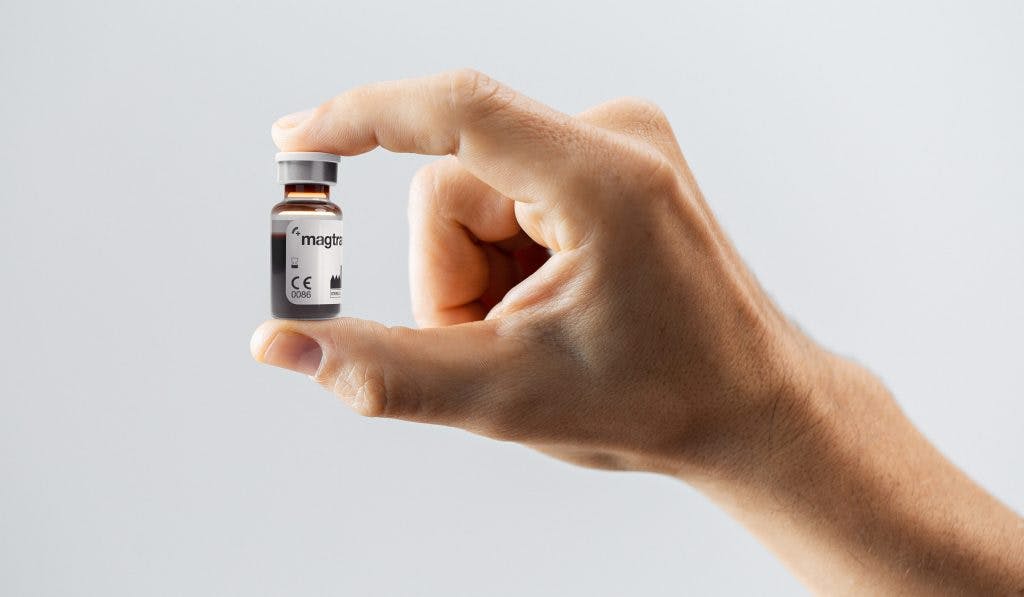Frequently asked questions
Magtrace® is a uniquely designed non-radioactive liquid tracer used to map the potential spread of cancer to the axilla in sentinel lymph node biopsy procedures. The liquid is made up of tiny particles of iron oxide, coated in sugar and suspended in saline.

Magtrace visually marks the sentinel lymph nodes. It is injected into the breast ahead of surgery, where it will travels through the lymphatic system to the Sentinel lymph nodes in the axilla. It will then provide a signal that is detectable using the Sentimag® probe, to help remove the target nodes during surgery.
No. Magtrace is the world’s first non-radioactive tracer to offer dual identification. This not only facilitates the eradication of radioactive products from the OR, but provides psychological benefits for the patient.
Magtrace® can be administered by in clinic, days, weeks or months ahead of surgery, or in the operating room just ahead of surgery.
Peritumoral injection is recommended as it:
- Migrates accurately and optimally to the nodes from the tumor site
- Can enhance detection rates
- Facilitates precision surgery
- Makes it easier to use alongside Magseed in the breast for all-in-one magnetic surgery.
- Limits potential discoloration, due to deeper injection
- Reduces incidence of MRI interference, as most of Magtrace is removed with the tumor.
If injecting in the OR with a subareolar technique, follow with 5 minutes of vigorous massage at the injection site. Surgeons should then wait at least 20 minutes before attempting transcutaneous measurement of the axilla.
Magtrace offers unrivalled scheduling flexibility. It can be injected in clinic weeks before surgery or under anaesthesia in the operating room.
Vigorous tissue-massage is advised if the Magtrace lymphatic tracer is administered shortly before surgery (20 minutes) and/or the breast is large, to ensure adequate uptake in the lymph nodes before surgery begins.
One of the benefits of the Magtrace® lymphatic tracer is that it acts as a dual identification tracer. As well as providing audio feedback to help intuitively find the sentinel nodes with the Sentimag® probe, it also discolors the node a brownish colour, offering visual backup.
Magtrace is a dual tracer, which means that it provides both audio (through the magnetic signal) and visual confirmation (staining the node) as you get closer to your target tissue.
Blue dye is only capable of providing a visual signal, which means it can be more complicated to identify initially, and skin staining has been shown to be more severe in clinical studies. Blue dye can also only be injected on the day of surgery, compared to Magtrace, which can be injected weeks ahead of surgery.
For some patients, Magtrace leaves a brown ‘bruise-like’ colouration, but studies have shown that in the majority of cases this will fades over time.
One of the benefits of injecting Magtrace peritumorally is that it reduces the likelihood of staining due to the deeper injection, and significant removal of the tracer when the tumor is excised.
Find out more about staining on our Magtrace clinical data page.
Unlike blue dye tracers, which have in some studies reported cases of anaphylaxis in up to 4% of patients, no significant adverse effects have been recorded for Magtrace®.
Yes. Several centers now use these products in combination. It is important to note that currently the Sentimag® probe does not distinguish between the signal from a Magseed® marker and the Magtrace® lymphatic tracer.
It is sensible to separate the injection site from the area you wish to sense the Magseed marker transcutaneously. A distance of 2-3 cm will ensure a separate signal for the Magseed marker to be attained.
Magtrace is MRI conditional, and safe to use in conjunction with MRI scanning. It will create an artefact on MRI, though the extent and intensity of the artefact depends on several factors.
- Injection volume
- Injection location
- Local iron concentration
- The extent of surgical resection
Even in cases that have a large artefact the scan is usually readable using subtraction images.
The price of Magtrace® differs from country to country. For more information click here to get in touch with our team of experts.
Outside of the cost of Magtrace, there are many assessments of node localization that have shown significant cost savings for hospitals. This should also be considered alongside the price of the tracer.
Simply submit your details here and someone will be in touch soon to arrange an evaluation.
If you’ve not found the answer you are looking for, please get in touch with our team. We'll be happy to help.

